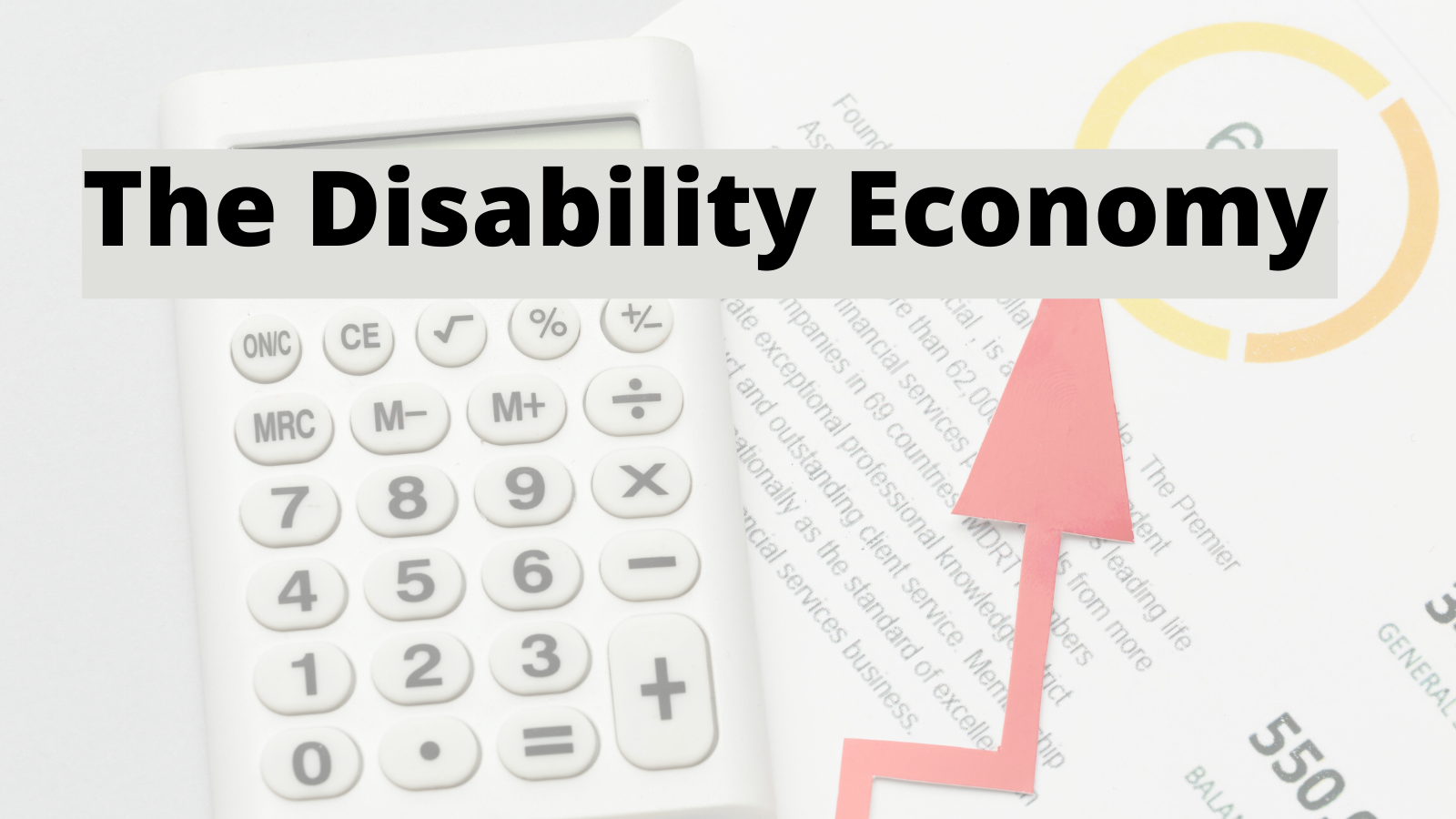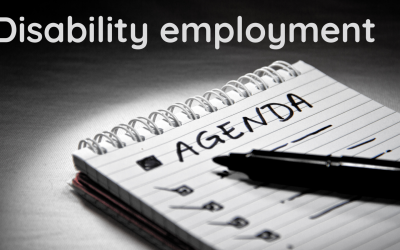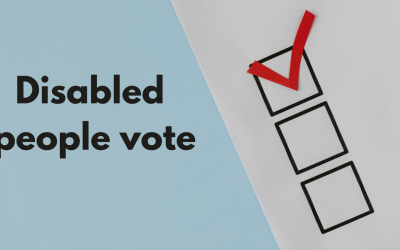I gave a speech at the Disability Employment Australia Conference on June 1, about the Disability Economy, and the economics of the NDIS, asking some hard questions about whether disabled people are part of this economy, or the products to be traded.
Introduction
I’m a disabled person, advocate and writer and I have worked professionally in the disability and community sectors in policy, communications and campaigns for over two decades.
My experiences in employment, like most other disabled people, has been mixed, to be kind. I have experienced prejudice and discrimination, I’ve been told I look too disabled to be in public at work, I’ve been told that the adjustments I require are too much. These experiences are common, and aren’t improving.
Over the last decade, billions of dollars have been added to what I call the Disability Economy, through the funding for the National Disability Insurance Scheme and to employment providers. But little of that money or the jobs that it has delivered have gone to disabled people. It’s time for us to get our fair share.
I’m going to touch on some history, and look at the economics of the NDIS, and how disabled people are thought of. And then I’m going to look at why little of this investment, or fancy strategies, are tackling the actual barriers we face. And I’ll leave you with some challenges about how to fix that.
What is the situation?
The disability employment gap hasn’t changed much at all in decades. The most recent ABS data shows 53% of disabled people of working age are in work compared to 84% of our non-disabled peers. The more severe a person’s disability, the less likely they are to be in work with only 25% of people with a severe or profound disability in work. 32% of people with an intellectual disability are in work, many of them earning sub-minimum wages in sheltered workshops, or Australian Disability Enterprises.
Women with disability are less likely to be employed that men, migrant and refugees with disability are less likely to be employed than people with disability born in Australia, and First Nations people with disability are less likely to be employed that other First Nations people.
People with disability are shut out of employment and half of us live in poverty, relying on meagre income support payments.
A long history
There is a long long history in Australia of excluding disabled people, including from work. Australia’s national identity was based for decades on an ideal of a white, non-disabled man, excluding First Nations people, women, non-white migrants and refugees and disabled people. Australia is often praised for the early introduction of the invalid pension, recognising the need to support people who couldn’t work. Yet that pension excluded, in the very legislation, “Aliens, Asiatics or Aboriginal natives of Australia, Africa, the Islands of the Pacific, or New Zealand”.
Before Federation, disabled people were sent to institutions if they couldn’t work. For First Nations people, colonisation of Australia had an enormous impact – their land was stolen, the Frontier wars and massacres and the spread of disease all combined to devastating consequences for First Nations people, include increasing the number of First Nations disabled people.
This long history isn’t the subject of this talk, but it is important to understand that exclusion of disabled people from the community is built on generations of prejudice and discrimination against us. And this exclusion will need more than a marketing campaign about confidence to overcome.
The old system and why a change was needed
Before I get into a discussion about the NDIS and employment, I want to touch briefly on what disability support came before, who bore the costs and WHY the NDIS was introduced in the first place.
The Shut Out report, written from hundreds of submissions from disabled people and their families in 2009, described the pre-NDIS world. The report said:
“People with disabilities and their families, friends and carers reported living lives of ‘fear and desperation’, despised by many in the community for their reliance on the pension, yet unable to access the support they required to move off it. Gripped by poverty, the cost of basic necessities was sometimes even beyond them.”
The original 2011 Productivity Commission report into the NDIS says in its very first pages that the costs of doing nothing to change the disability support system would not be sustainable.
Those radicals at the Productivity Commission said that a new system was needed to address ‘the hidden future liabilities’ of the old system and that ‘from an economic perspective, the benefits of the NDIS will exceed the costs.’
The NDIS was intended to share the costs of disability among the whole community, rather than continuing the load on disabled people and our families. The Scheme was to both ease individual cost burdens, but to also open up the community for us, including disabled people more in the mainstream, such as employment.
Now, just over 500,000 disabled people have disability supports through the NDIS, many for the first time in their lives. This is a very good news story. Disabled people who are eligible and their families no longer have to mortgage their houses to pay for essential equipment, or appeal to charities to fund mobility aids. Carers, mostly women, are no longer expected to give up paid employment to provide unpaid care, and family budgets are no longer dominated by expensive allied health and other therapy programs. Disabled people don’t have to spend precious resources from their pensions or employment to get vital gear, or fit into narrow eligibility criteria for a few hours of home support.
Of course, all of that also highlights that for disabled people outside the NDIS, the costs of being disabled and excluded still remain.
The NDIS and employment
Before the recent Federal Election, there were a series of articles in the Australian Financial Review, the ABC and the Australian that all questioned the investment in the NDIS. Wild claims were made about how expensive disabled people are, and how the ‘NDIS wasn’t working’ because more of us hadn’t moved into employment. Headlines screamed about actuarial reports that claimed the NDIS would cost more than Medicare at $60b a year by the end of the decade.
Despite the NDIS only being in full rollout for a few years, alongside the uncertainty caused by the independent assessments debacle and the ever present fear of cuts to essential supports, disabled people were scolded by non-disabled journalists for our profligate waste of precious taxpayers money.
Economics of the NDIS
So how do we measure the economic impact of the NDIS?
The Annual Financial Sustainability Report, and the recent Taylor and Fry report, which have been behind most of the headlines about the costs of the NDIS, only measure a narrow set of outgoings. They don’t take a holistic view of these kinds of key economic indicators such as the impact on the wellbeing of disabled people and families, or of the wider growth in of what I call the disability economy.
At the same time, the previous Federal Government talked a lot about their economic and job creation record, pointing to increased activity and job numbers. In the election campaign, unemployment was reported at record lows of 3.9%, rates not seen for 1970s.
Mining, in particular, gets talked about as a key driver of job creation and economic success, which in turn is promoted as being how we pay for the NDIS. The former Prime Minister and the former Deputy Prime Minister often said that their economic plans that prioritised more coal and gas mining were needed to pay for the NDIS.
But what if the NDIS was more responsible for this economic growth and jobs recovery that you might think?
The original Productivity Commission report said that ‘The NDIS would only have to produce an annual gain of $3800 per participant to meet a cost-benefit test.’ They explicitly say that by 2050, a conservative estimate was 100,000 more disabled people in work, and more likely 250,000 people. This could equal a one percent increase to GDP, translating to $32 billion a year.
Note that the Commission sees this as a long term goal, more than 25 years into the future.
The Per Capita think tank estimated that there have been 270,000 jobs created out of the NDIS and that ‘the economic contribution of the NDIS in 2020-2021 is around $52.4 billion’.
These direct economic impacts of the NDIS aren’t measured by any of the actuarial reports that lead to scary headlines and poor public policy responses, such as independent assessments.
The final inquiry from the Joint Standing Committee on the NDIS from the last Parliament was to look at the economic modelling and forecasting work that was being done. They made six recommendations, with the last two being that the NDIS Actuary and Board broaden the way they look at financial sustainability and include research about the economic benefits of the scheme.
I hope the new government takes up these recommendations and we can start to have a better, broader discussion about the economic impact of the NDIS.
The NDIS and employment
But has all this investment in the disability economy had any impact on disabled people themselves, particularly into employment? There is starting to be some movement in the number of people with disability and their families who are getting paid work, with that increasing the longer people are in the NDIS. There are more young people with disability moving into employment, but the NDIS still isn’t differentiating in their data between open and supported employment. For people with intellectual disability, they are still overwhelmingly employed in sheltered workshops, on sub-minimum wages.
But there hasn’t been a huge shift of disabled people into open and self-employment.
Why is this and what can we do to make sure that disabled people aren’t left in poverty? Has the NDIS actually been about jobs for non-disabled people, rather than for us?
What is the NDIS doing?
In response to concerns about how few disabled people who get NDIS supports are in work, the NDIS developed a Participant Employment Strategy.
They have five focus areas that look at changing disabled people, doing something fancy with the market, building employer confidence, and leading by example as an employer:
The NDIS has reported about how they are going with this, saying that while it is increasing, only 34% of working age people with NDIS plans even have work in their goals.
The ABC recently reported that for many disabled people who work at the NDIA, it’s not a positive experience.
The NDIS strategy doesn’t name discrimination and prejudice as key drivers of our exclusion from the workplace.
A review for DSS in 2017 found that “Prejudice and negative stereotypes around people with disability are identified as significant barriers to the employment of people with disability.”
The Australian Government’s new Disability Employment Strategy, called Employ My Ability, does name some of these barriers for disabled people. Discrimination, bullying, lack of adjustments, and negative attitudes all get a mention.
But while they acknowledge that these exist, there isn’t any real measures to address this discrimination or exclusion, beyond broad statements about employers becoming ‘disability confident’, again, as though discrimination is fixed by employers feeling better about themselves.
And yet, the NDIS doesn’t even look at these, nor see any role for the Agency in tackling the exclusion of disabled people from the community, including employment.
The NDIS, along with other government investment in the disability economy, has missed the chance to drive social change through specific measures that demand inclusion. Instead, they have left much of this to an unregulated market, with few obligations made upon those who benefit from all that investment.
Who is getting the economic benefit of the NDIS?
In much of the last two years of discussions about the costs of the NDIS, disability service providers, both private and not for profit, have vanished from view. My analysis of the large not for profit providers shows that most of them have doubled or even tripled in size.
Organisations like Life Without Barriers, Sunnyfield and Afford have fronted the Disability Royal Commission to explain why people with disability have been abused while living in homes run by these providers. The Royal Commission has heard of violence and abuse, huge increases in revenue, pressure to cherry pick those people with disability with large plans, conflict with families and little to no choice offered to disabled people. It has been gut-wrenching listening.
Other private companies, like APM, have listed on the stock exchange, for close to a billion dollars. A company called McMillan-Shakespeare Group, that specialises in “salary packaging, novated leasing, asset management and related financial products and services” now also manages NDIS plans, and is worth millions a year. They are just a few examples.
So much money has come into disability services, both for support, but also for employment services. And yet, there are no requirements for any of these organisations to employ us in order to get that money.
Instead, much of this money has gone to increasing the size of the separate disability sector, where disabled people live in segregated housing, get their disability supports, work in sheltered workshops and have even the support coordination all provided by the same provider.
Disabled people are still separated from the rest of the community, particularly for people with an intellectual disability, instead of the dream ten years ago that fuelled the campaign for the NDIS of being more included in the community. Which includes having a job and not living in poverty.
Where is our share?
I am sure you can hear that I am cranky about this. So much money has poured into the disability economy, yet over half of disabled people still live in poverty. Hundreds of thousands of jobs are created for non-disabled people, and yet far too many of us are shut out of a workplace that still isn’t making room for us.
There has been little work done to tackle the biggest barriers we face to getting and keeping a job – discrimination and a lack of adjustments.
It wasn’t lost on many of us that the accommodations that so many disabled people needed, and were refused, were suddenly available when non-disabled people needed them during COVID. And so quickly, as soon as regulations said they were mandatory. Because this flexibility was never hard to do, but attitudes and discrimination against disabled people meant they didn’t happen.
The expansion of a separate disability world, rather than work to include us in the mainstream, has done little to tackle discriminatory attitudes towards disabled people. A recent large survey from the Centre of Research Excellence in Disability and Health found that half of people thought it was ok for employers to refuse to hire disabled people.
Naming the actual barriers against us in employment is vital to addressing them. If we aren’t being honest about what is happening, how on earth can we address the disability job gap?
It’s time to stop banging on about employer confidence and instead insist that we are an integral part of the disability economy, as active contributors and equal partners.
We don’t need another pilot program, or research, or strategy. What we need is action.
All the confidence building in the world hasn’t led to more disabled people getting hired, so I suggest that governments use the levers they have to insist on change and get more disabled people in the door. Our inclusion will always be theoretical until we are in the room, sitting next to you in meetings, sharing a roster and going to staff meetings.
What if instead of talking about how expensive disabled people are, we insisted that every single disability service provider had a minimum quota of 15% of their staff to be disabled people, at every level of the organisation. What if NDIS registration was conditional on this quota being met, as well as having disabled people on the board? What if every disability employment service had to employ at least 15% disabled people? What if all government contracts about disabled people could only go to organisations that employed disabled people? Better yet, were led by disabled people.
This would force a change in attitude and a change in how organisations would run. It would force workplaces to engage with finding disabled people and making sure they have what they need to do their jobs. This would ensure that the expertise of disabled people was part of every disability organisation and service. This would include more disabled people as equals in the workplace, rather than always as the clients. This would also make disability services, of all kinds, better, because the expertise we hold as disabled people can’t be matched. With the Disability Royal Commission due to hand down their recommendations next year, the time to get disabled people in the room is now.
So my challenge to you all today is about employing disabled people. How many disabled people work in your workplace? How many people with disability are running your organisations? How many disabled people are on your boards? How many people with disability are designing your employment supports? How many disabled people are liaising with employers about making sure workplaces are safe for us?
The NDIS has built a new disability economy, and now it is time to get serious about our inclusion and make sure that disabled people get our fair share of that.





